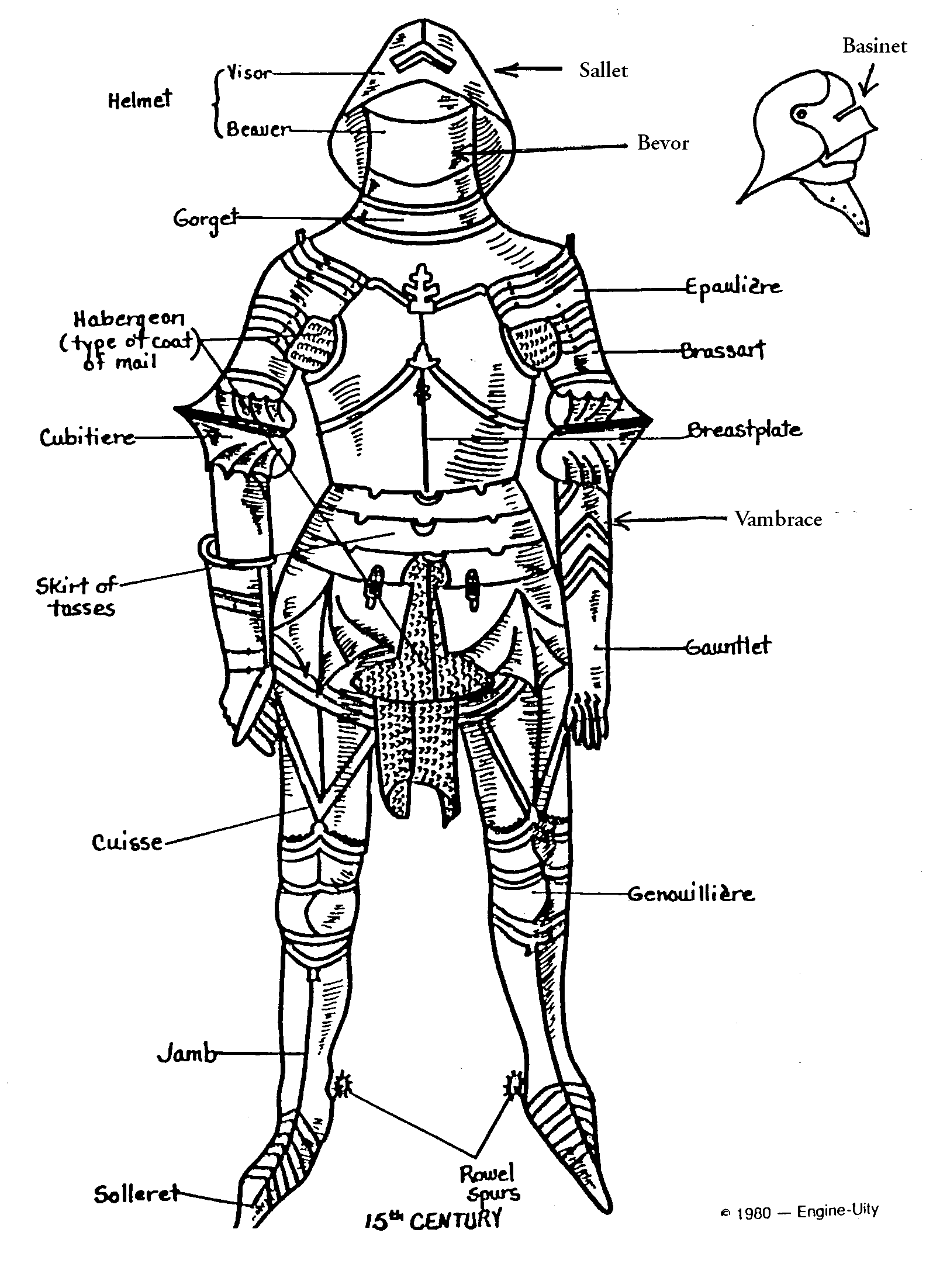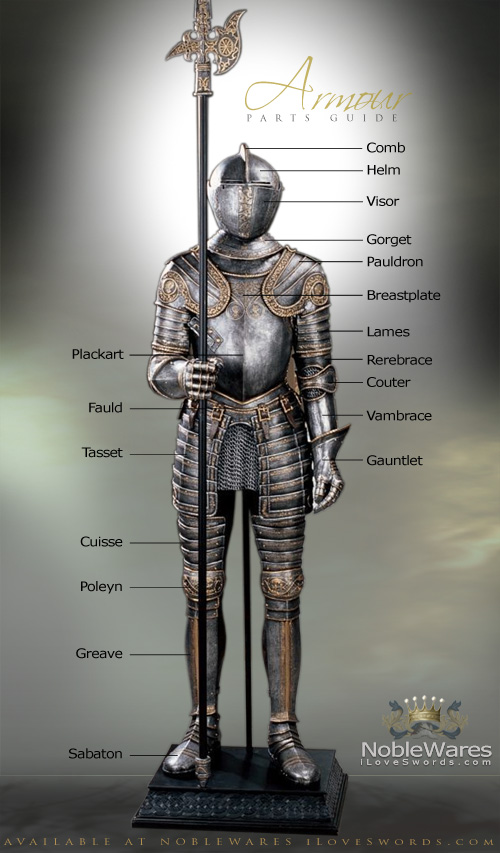
Metal Medieval Knight Armor Parts Stock Image Image of antique
Exploring the different parts of medieval armor allows us to delve into a world where strength and resilience were embodied in every meticulously crafted plate. 1 The Origins of Chainmail Armors in Medieval Warfare. 2 Introduction. 3 Ancient Beginnings. 4 Romans and Beyond. 5 Middle Ages Takeover.

Components of medieval armour Wikipedia Medieval armor, Armor
1 1. The Different Parts of a Medieval Knight's Armor 2 A Personal Story: The Tale of Sir Dunkelwolf and His Armor Collection 3 2. The Evolution of Design and Functionality in Medieval Armor Parts 4 A Personal Story: Sir Dunkelwolf's Quest for the Perfect Armor 5 3. Protecting the Head and Neck: The Role of Medieval Helmet

Armour History, Types, Definition, & Facts Britannica
The Importance of Armor Materials The materials used in medieval armor were carefully selected to provide the necessary protection for the wearer. The primary goal of armor was to safeguard the body from the weapons used in battle, such as swords, axes, and arrows.

Pub Quiz Reference Parts of a Suit of Armour Medieval knight armor
The article discusses the main components of a typical medieval suit of armor, including helmets, breastplates, gauntlets, and leg protection, highlighting their purpose and design.

Medieval 2 Total War Heaven Medieval Armour A brief guide
5. The Purpose and Function of a Gauntlet in Medieval Armor Definition and Design. A gauntlet, also known as a hand armor or glove, was an integral part of medieval armor that protected the knight's hands during battle. It consisted of multiple metal plates that covered the fingers, back of the hand, and wrist.

Metal Medieval Knight Armor Parts Stock Photo Image of castle, rough
The history of medieval armor dates back to the early medieval period from the fall of the Roman Empire in Western Europe around c.500. It is not until the latter part of the high medieval period around c.1200 that the 'Galant Knight in Shining Armour' in full plate armor started to evolve.. The first cuirass *Latin: coriaceus *The rigid armor plate that covered the entire torso of a.

Parts of Ancient Knight`s Armor.a Medieval Concept Stock Image Image
The medieval period was a time of constant warfare, and armor played a crucial role in protecting knights and soldiers from enemy weapons. "The development of medieval armor was a reflection of the changing nature of warfare and the need for better protection. From the early days of chainmail to the full plate armor of the Late Middle Ages.

Metal Medieval Knight Armor Parts Stock Image Image of knight
Plate Armour A to Z List Back Plate Armour Metal Plate in either 1, 2, or 3 pieces that protected the back - Found in early and late medieval times Bard - Horse Plate Armour The term is used for plate armor but is mainly used to describe horse armor. The Bard protected the breast and flanks area.

Armor part names Knight armor, Vambrace, Armor drawing
Medieval Armour Parts 1 -The Helmet or Helm The medieval helmet has a long and varied history. Helmets were used in ancient times, but they were generally simple in design and made of materials such as leather or bronze. It was not until the Middle Ages that helmets became more advanced, with the development of the full-faced helmet.

Parts of a Suit of Armor Arms and armour, Medieval armor, Historical
Viking Age arms and armour. Knowledge about military technology of the Viking Age (late 8th to mid-11th century Europe) is based on relatively sparse archaeological finds, pictorial representations, and to some extent on the accounts in the Norse sagas and laws recorded in the 12th-14th century. According to custom, all free Norse men were.

Parts from a French Armour for the Tilt 1550/75 Medieval armor
Manfred Richter (CC BY) Armour pieces have survived from the medieval period, and besides these, historians rely on descriptions in contemporary texts, illustrations, and the stone tombs of knights which were frequently topped by a life-size carving of the deceased (effigy) in full battledress.

Medieval Armor and Weapons in the Later Middle Ages
Chainmail: A type of armor made from interlocked metal rings. Each of these parts played a crucial role in protecting the knight from harm. And each part was carefully designed and crafted to ensure maximum protection while allowing the knight to move and fight effectively.

Suit of Armour Parts Guide
[1] The use of plate armour began to decline in the early 17th century, but it remained common both among the nobility (The most important figures of the time like the Emperor Ferdinand II, Louis XIII, Philip IV of Spain, Maurice of Orange and Gustavus Adolphus wore plate armor.) and for the cuirassiers throughout the European wars of religion.

Parts of Shinning Medieval Armour Stock Photo Image of hero, chivalry
Early Middle Ages: Armour began as chainmail, a flexible but heavy garment made of interlocked metal rings. The Norman helmet, with its nasal bar, was also common. High Middle Ages: Plate armour started to supplement chainmail for better protection. Helmets like the Great Helm offered superior protection but limited visibility and ventilation.

Parts Of A Medieval Knight Armor Stock Photo 101789620 Shutterstock
Looking for Medieval Armours? We have almost everything on eBay. No matter what you love, you'll find it here. Search Medieval Armours and more.

Parts of the Medieval Knight Medieval Combat, Medieval Weapons
Give good old Wikipedia a great new look This list identifies various pieces of body armour worn from the medieval to early modern period in the Western world, mostly plate but some mail armour, arranged by the part of body that is protected and roughly by date.